Mechanical Engineering Assignment 2: Aerofoil and Flight Forces
VerifiedAdded on 2022/11/14
|16
|1650
|426
Homework Assignment
AI Summary
This document presents a comprehensive solution to an assignment focused on aerofoil sections and flight forces in subsonic flight. It begins with calculations of lift and drag coefficients, followed by an analysis of wingtip vortices and the effects of relative airflow and angle of attack. The assignment further explores the concepts of static and dynamic pressure, Bernoulli's principle, and the Venturi principle. It also delves into different types of drag, including skin friction, form, interference, and lift-induced drag, along with the impact of wing aspect ratio. The solution includes detailed explanations, calculations, and references to relevant literature, providing a thorough understanding of the subject matter. The assignment covers topics like zero-lift drag and lift-induced drag in relation to airspeed, and concludes with calculations for wing aspect ratio, including an Excel sheet and graphical representations of the drag and lift to drag ratio, and the speed for minimum drag.
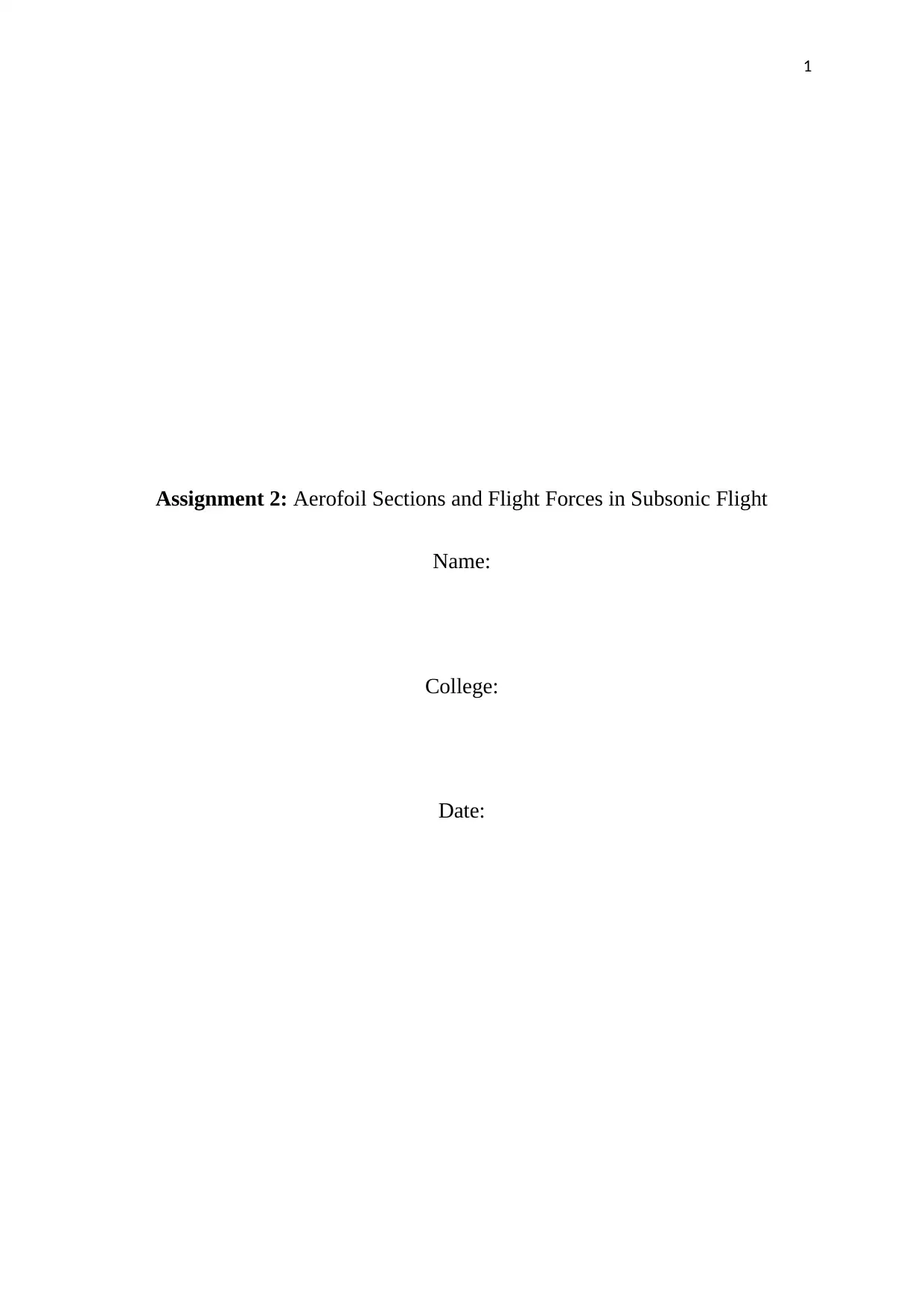
1
Assignment 2: Aerofoil Sections and Flight Forces in Subsonic Flight
Name:
College:
Date:
Assignment 2: Aerofoil Sections and Flight Forces in Subsonic Flight
Name:
College:
Date:
Paraphrase This Document
Need a fresh take? Get an instant paraphrase of this document with our AI Paraphraser
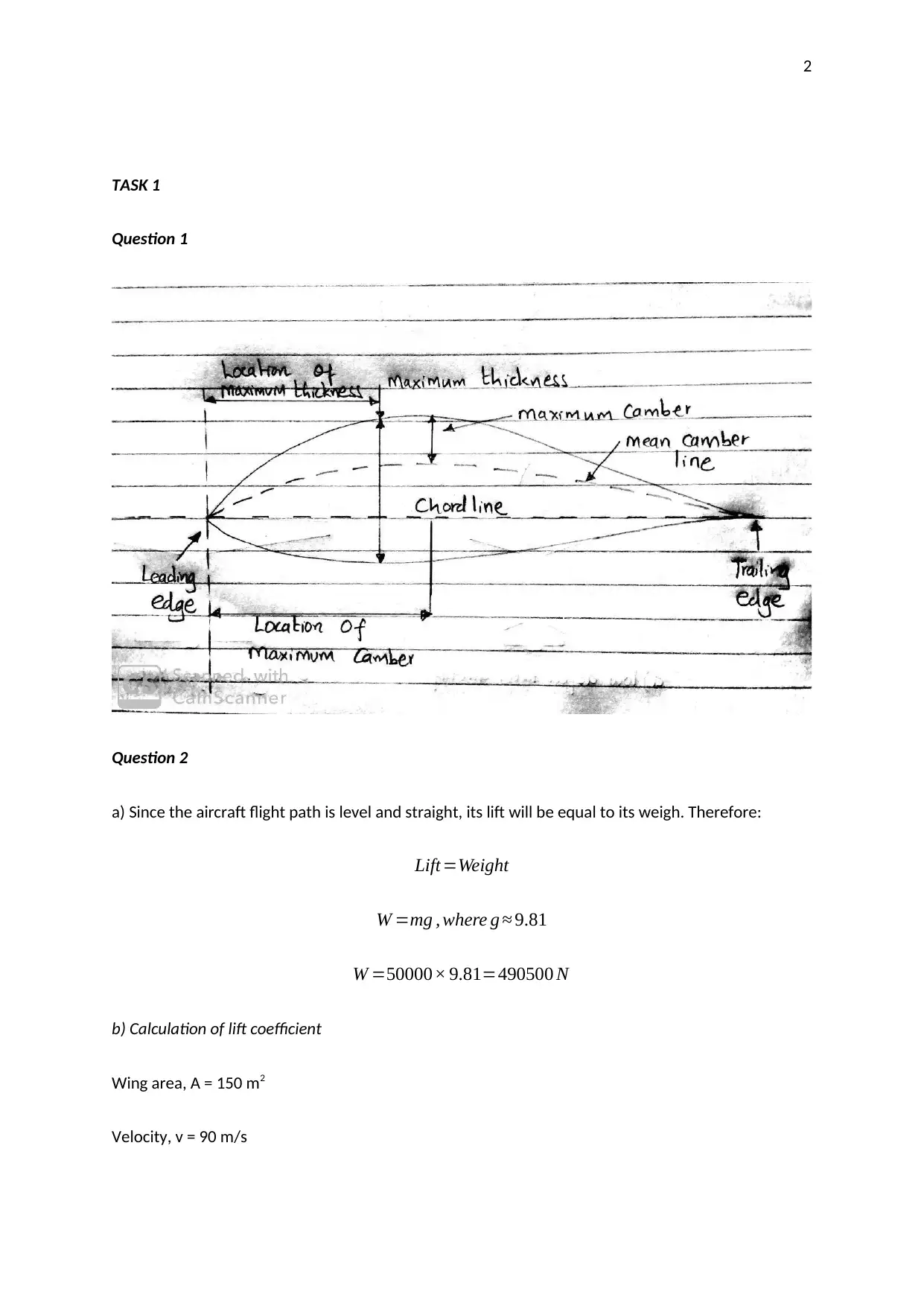
2
TASK 1
Question 1
Question 2
a) Since the aircraft flight path is level and straight, its lift will be equal to its weigh. Therefore:
Lift =Weight
W =mg , where g ≈ 9.81
W =50000× 9.81=490500 N
b) Calculation of lift coefficient
Wing area, A = 150 m2
Velocity, v = 90 m/s
TASK 1
Question 1
Question 2
a) Since the aircraft flight path is level and straight, its lift will be equal to its weigh. Therefore:
Lift =Weight
W =mg , where g ≈ 9.81
W =50000× 9.81=490500 N
b) Calculation of lift coefficient
Wing area, A = 150 m2
Velocity, v = 90 m/s
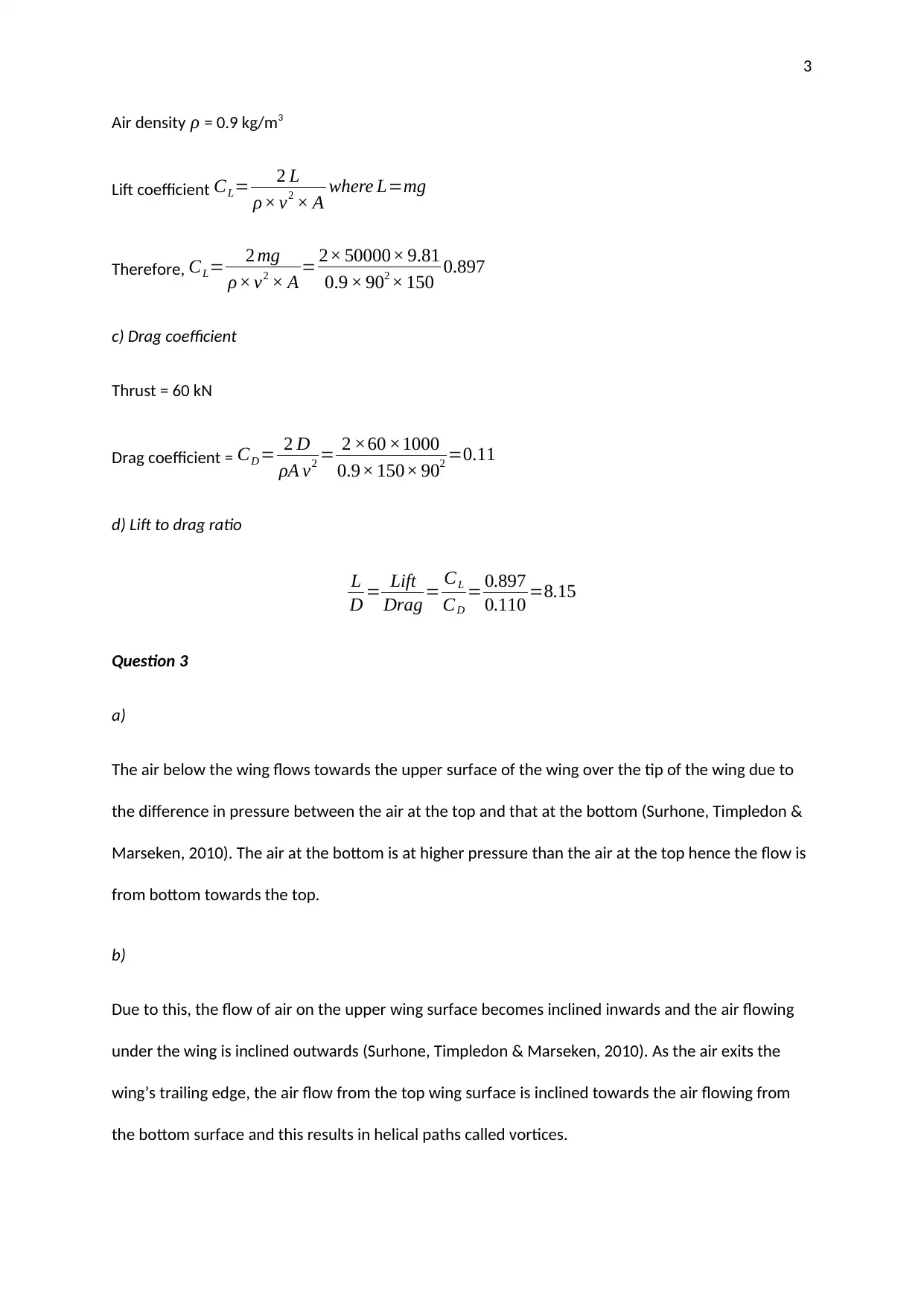
3
Air density ρ = 0.9 kg/m3
Lift coefficient CL= 2 L
ρ× v2 × A where L=mg
Therefore, CL= 2 mg
ρ× v2 × A = 2× 50000× 9.81
0.9 × 902 × 150 0.897
c) Drag coefficient
Thrust = 60 kN
Drag coefficient = CD = 2 D
ρA v2 = 2 ×60 ×1000
0.9× 150× 902 =0.11
d) Lift to drag ratio
L
D = Lift
Drag = CL
CD
= 0.897
0.110 =8.15
Question 3
a)
The air below the wing flows towards the upper surface of the wing over the tip of the wing due to
the difference in pressure between the air at the top and that at the bottom (Surhone, Timpledon &
Marseken, 2010). The air at the bottom is at higher pressure than the air at the top hence the flow is
from bottom towards the top.
b)
Due to this, the flow of air on the upper wing surface becomes inclined inwards and the air flowing
under the wing is inclined outwards (Surhone, Timpledon & Marseken, 2010). As the air exits the
wing’s trailing edge, the air flow from the top wing surface is inclined towards the air flowing from
the bottom surface and this results in helical paths called vortices.
Air density ρ = 0.9 kg/m3
Lift coefficient CL= 2 L
ρ× v2 × A where L=mg
Therefore, CL= 2 mg
ρ× v2 × A = 2× 50000× 9.81
0.9 × 902 × 150 0.897
c) Drag coefficient
Thrust = 60 kN
Drag coefficient = CD = 2 D
ρA v2 = 2 ×60 ×1000
0.9× 150× 902 =0.11
d) Lift to drag ratio
L
D = Lift
Drag = CL
CD
= 0.897
0.110 =8.15
Question 3
a)
The air below the wing flows towards the upper surface of the wing over the tip of the wing due to
the difference in pressure between the air at the top and that at the bottom (Surhone, Timpledon &
Marseken, 2010). The air at the bottom is at higher pressure than the air at the top hence the flow is
from bottom towards the top.
b)
Due to this, the flow of air on the upper wing surface becomes inclined inwards and the air flowing
under the wing is inclined outwards (Surhone, Timpledon & Marseken, 2010). As the air exits the
wing’s trailing edge, the air flow from the top wing surface is inclined towards the air flowing from
the bottom surface and this results in helical paths called vortices.
⊘ This is a preview!⊘
Do you want full access?
Subscribe today to unlock all pages.

Trusted by 1+ million students worldwide
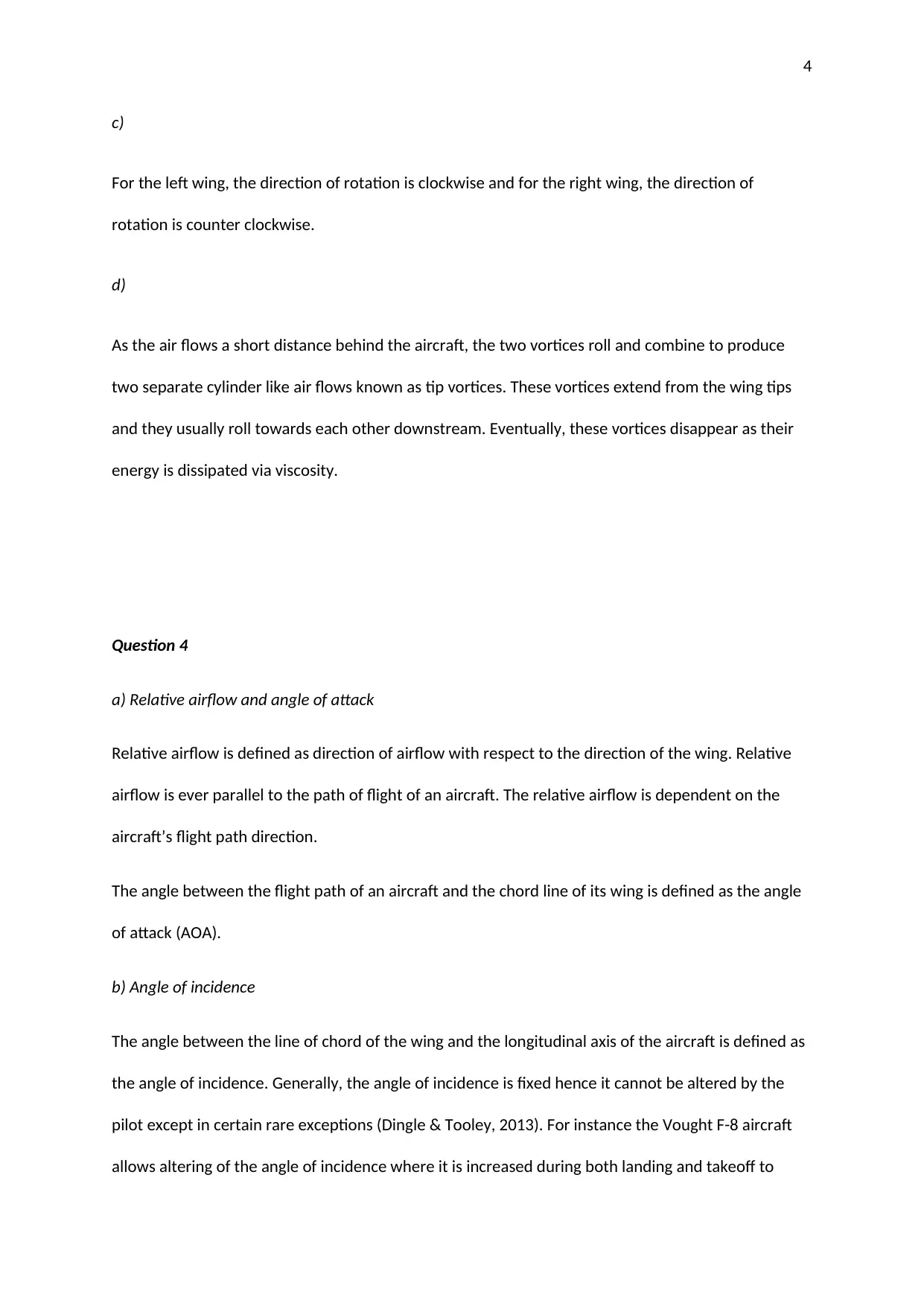
4
c)
For the left wing, the direction of rotation is clockwise and for the right wing, the direction of
rotation is counter clockwise.
d)
As the air flows a short distance behind the aircraft, the two vortices roll and combine to produce
two separate cylinder like air flows known as tip vortices. These vortices extend from the wing tips
and they usually roll towards each other downstream. Eventually, these vortices disappear as their
energy is dissipated via viscosity.
Question 4
a) Relative airflow and angle of attack
Relative airflow is defined as direction of airflow with respect to the direction of the wing. Relative
airflow is ever parallel to the path of flight of an aircraft. The relative airflow is dependent on the
aircraft’s flight path direction.
The angle between the flight path of an aircraft and the chord line of its wing is defined as the angle
of attack (AOA).
b) Angle of incidence
The angle between the line of chord of the wing and the longitudinal axis of the aircraft is defined as
the angle of incidence. Generally, the angle of incidence is fixed hence it cannot be altered by the
pilot except in certain rare exceptions (Dingle & Tooley, 2013). For instance the Vought F-8 aircraft
allows altering of the angle of incidence where it is increased during both landing and takeoff to
c)
For the left wing, the direction of rotation is clockwise and for the right wing, the direction of
rotation is counter clockwise.
d)
As the air flows a short distance behind the aircraft, the two vortices roll and combine to produce
two separate cylinder like air flows known as tip vortices. These vortices extend from the wing tips
and they usually roll towards each other downstream. Eventually, these vortices disappear as their
energy is dissipated via viscosity.
Question 4
a) Relative airflow and angle of attack
Relative airflow is defined as direction of airflow with respect to the direction of the wing. Relative
airflow is ever parallel to the path of flight of an aircraft. The relative airflow is dependent on the
aircraft’s flight path direction.
The angle between the flight path of an aircraft and the chord line of its wing is defined as the angle
of attack (AOA).
b) Angle of incidence
The angle between the line of chord of the wing and the longitudinal axis of the aircraft is defined as
the angle of incidence. Generally, the angle of incidence is fixed hence it cannot be altered by the
pilot except in certain rare exceptions (Dingle & Tooley, 2013). For instance the Vought F-8 aircraft
allows altering of the angle of incidence where it is increased during both landing and takeoff to
Paraphrase This Document
Need a fresh take? Get an instant paraphrase of this document with our AI Paraphraser
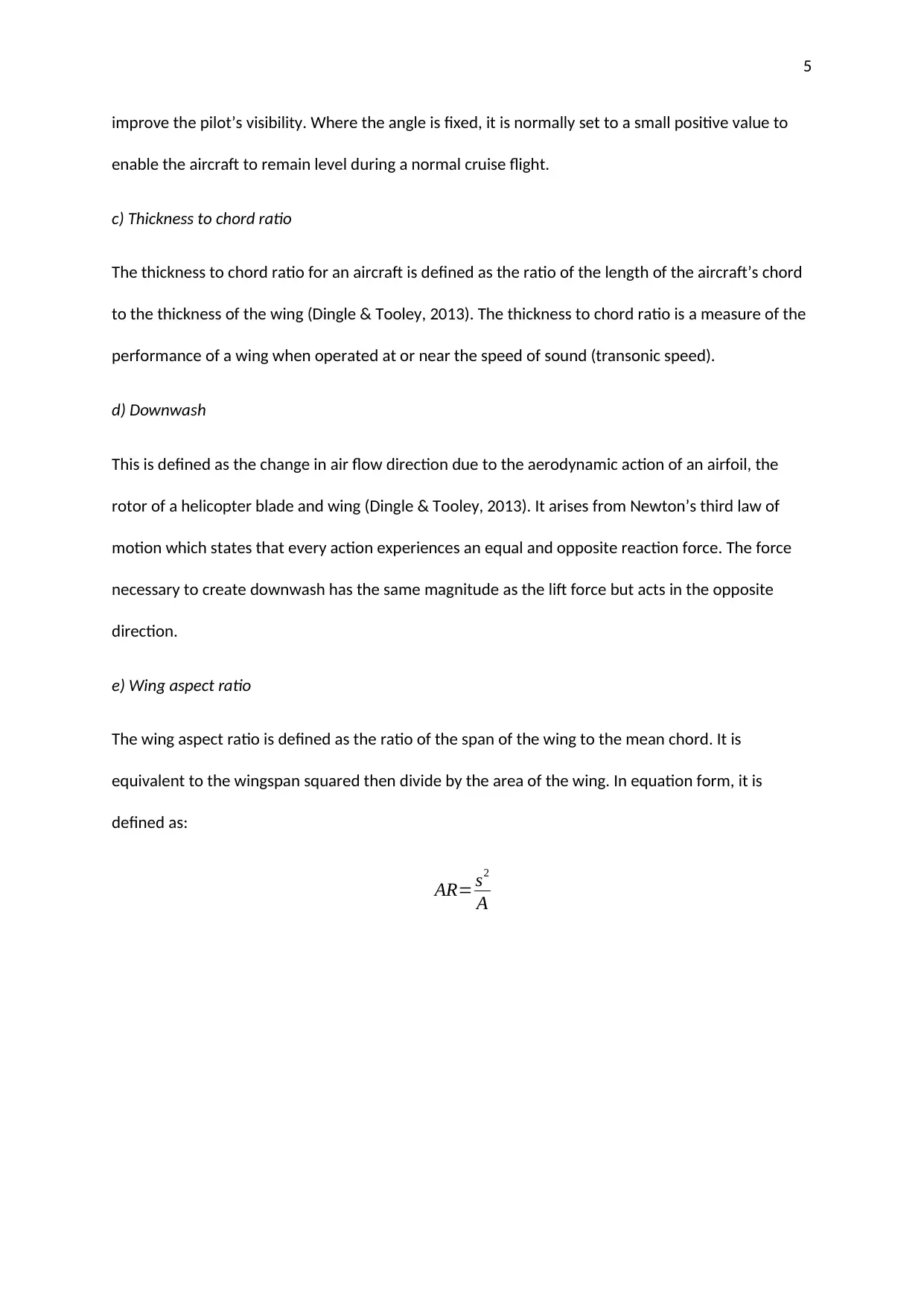
5
improve the pilot’s visibility. Where the angle is fixed, it is normally set to a small positive value to
enable the aircraft to remain level during a normal cruise flight.
c) Thickness to chord ratio
The thickness to chord ratio for an aircraft is defined as the ratio of the length of the aircraft’s chord
to the thickness of the wing (Dingle & Tooley, 2013). The thickness to chord ratio is a measure of the
performance of a wing when operated at or near the speed of sound (transonic speed).
d) Downwash
This is defined as the change in air flow direction due to the aerodynamic action of an airfoil, the
rotor of a helicopter blade and wing (Dingle & Tooley, 2013). It arises from Newton’s third law of
motion which states that every action experiences an equal and opposite reaction force. The force
necessary to create downwash has the same magnitude as the lift force but acts in the opposite
direction.
e) Wing aspect ratio
The wing aspect ratio is defined as the ratio of the span of the wing to the mean chord. It is
equivalent to the wingspan squared then divide by the area of the wing. In equation form, it is
defined as:
AR= s2
A
improve the pilot’s visibility. Where the angle is fixed, it is normally set to a small positive value to
enable the aircraft to remain level during a normal cruise flight.
c) Thickness to chord ratio
The thickness to chord ratio for an aircraft is defined as the ratio of the length of the aircraft’s chord
to the thickness of the wing (Dingle & Tooley, 2013). The thickness to chord ratio is a measure of the
performance of a wing when operated at or near the speed of sound (transonic speed).
d) Downwash
This is defined as the change in air flow direction due to the aerodynamic action of an airfoil, the
rotor of a helicopter blade and wing (Dingle & Tooley, 2013). It arises from Newton’s third law of
motion which states that every action experiences an equal and opposite reaction force. The force
necessary to create downwash has the same magnitude as the lift force but acts in the opposite
direction.
e) Wing aspect ratio
The wing aspect ratio is defined as the ratio of the span of the wing to the mean chord. It is
equivalent to the wingspan squared then divide by the area of the wing. In equation form, it is
defined as:
AR= s2
A
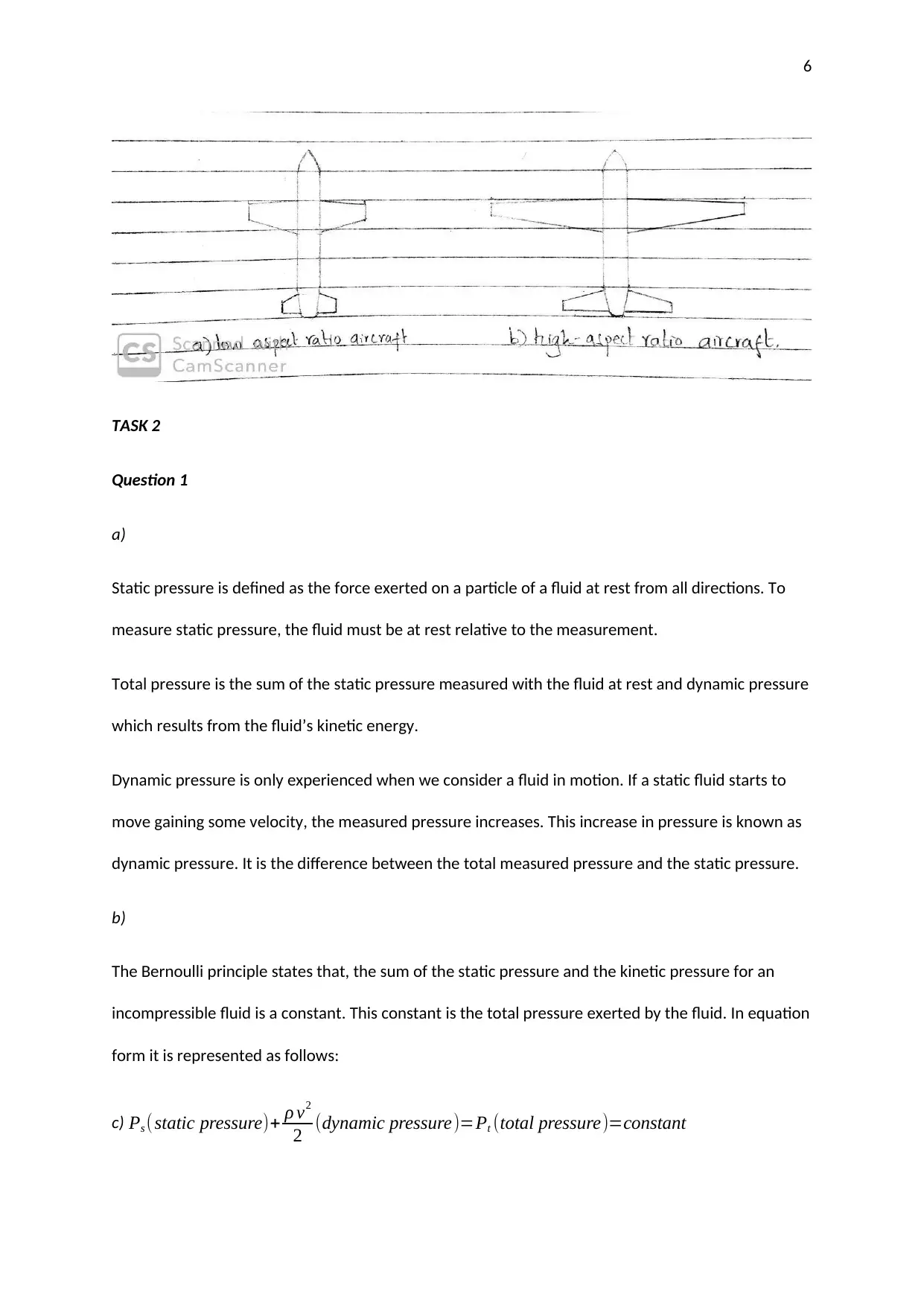
6
TASK 2
Question 1
a)
Static pressure is defined as the force exerted on a particle of a fluid at rest from all directions. To
measure static pressure, the fluid must be at rest relative to the measurement.
Total pressure is the sum of the static pressure measured with the fluid at rest and dynamic pressure
which results from the fluid’s kinetic energy.
Dynamic pressure is only experienced when we consider a fluid in motion. If a static fluid starts to
move gaining some velocity, the measured pressure increases. This increase in pressure is known as
dynamic pressure. It is the difference between the total measured pressure and the static pressure.
b)
The Bernoulli principle states that, the sum of the static pressure and the kinetic pressure for an
incompressible fluid is a constant. This constant is the total pressure exerted by the fluid. In equation
form it is represented as follows:
c) Ps ( static pressure)+ ρ v2
2 (dynamic pressure)=Pt (total pressure)=constant
TASK 2
Question 1
a)
Static pressure is defined as the force exerted on a particle of a fluid at rest from all directions. To
measure static pressure, the fluid must be at rest relative to the measurement.
Total pressure is the sum of the static pressure measured with the fluid at rest and dynamic pressure
which results from the fluid’s kinetic energy.
Dynamic pressure is only experienced when we consider a fluid in motion. If a static fluid starts to
move gaining some velocity, the measured pressure increases. This increase in pressure is known as
dynamic pressure. It is the difference between the total measured pressure and the static pressure.
b)
The Bernoulli principle states that, the sum of the static pressure and the kinetic pressure for an
incompressible fluid is a constant. This constant is the total pressure exerted by the fluid. In equation
form it is represented as follows:
c) Ps ( static pressure)+ ρ v2
2 (dynamic pressure)=Pt (total pressure)=constant
⊘ This is a preview!⊘
Do you want full access?
Subscribe today to unlock all pages.

Trusted by 1+ million students worldwide
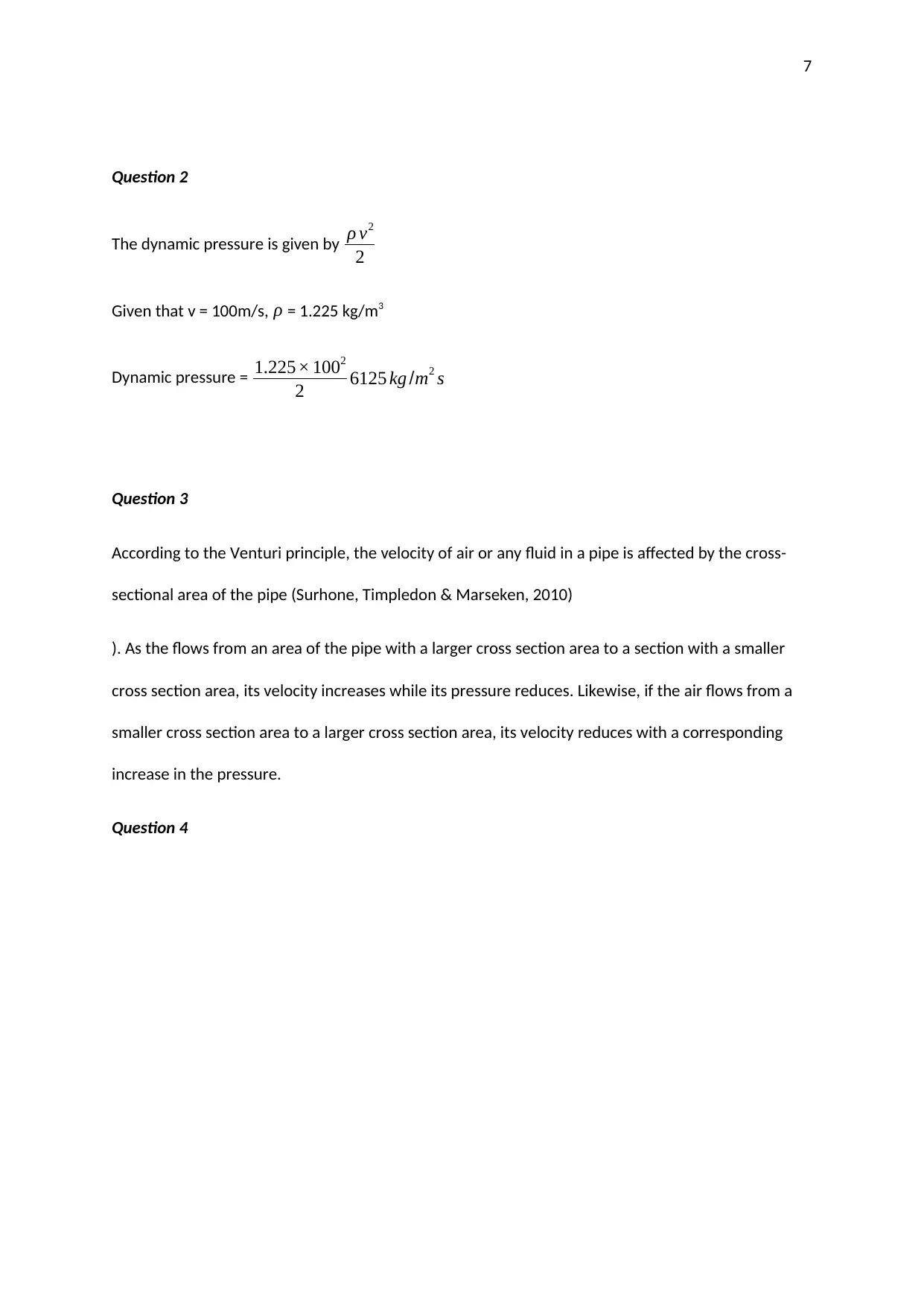
7
Question 2
The dynamic pressure is given by ρ v2
2
Given that v = 100m/s, ρ = 1.225 kg/m3
Dynamic pressure = 1.225× 1002
2 6125 kg /m2 s
Question 3
According to the Venturi principle, the velocity of air or any fluid in a pipe is affected by the cross-
sectional area of the pipe (Surhone, Timpledon & Marseken, 2010)
). As the flows from an area of the pipe with a larger cross section area to a section with a smaller
cross section area, its velocity increases while its pressure reduces. Likewise, if the air flows from a
smaller cross section area to a larger cross section area, its velocity reduces with a corresponding
increase in the pressure.
Question 4
Question 2
The dynamic pressure is given by ρ v2
2
Given that v = 100m/s, ρ = 1.225 kg/m3
Dynamic pressure = 1.225× 1002
2 6125 kg /m2 s
Question 3
According to the Venturi principle, the velocity of air or any fluid in a pipe is affected by the cross-
sectional area of the pipe (Surhone, Timpledon & Marseken, 2010)
). As the flows from an area of the pipe with a larger cross section area to a section with a smaller
cross section area, its velocity increases while its pressure reduces. Likewise, if the air flows from a
smaller cross section area to a larger cross section area, its velocity reduces with a corresponding
increase in the pressure.
Question 4
Paraphrase This Document
Need a fresh take? Get an instant paraphrase of this document with our AI Paraphraser
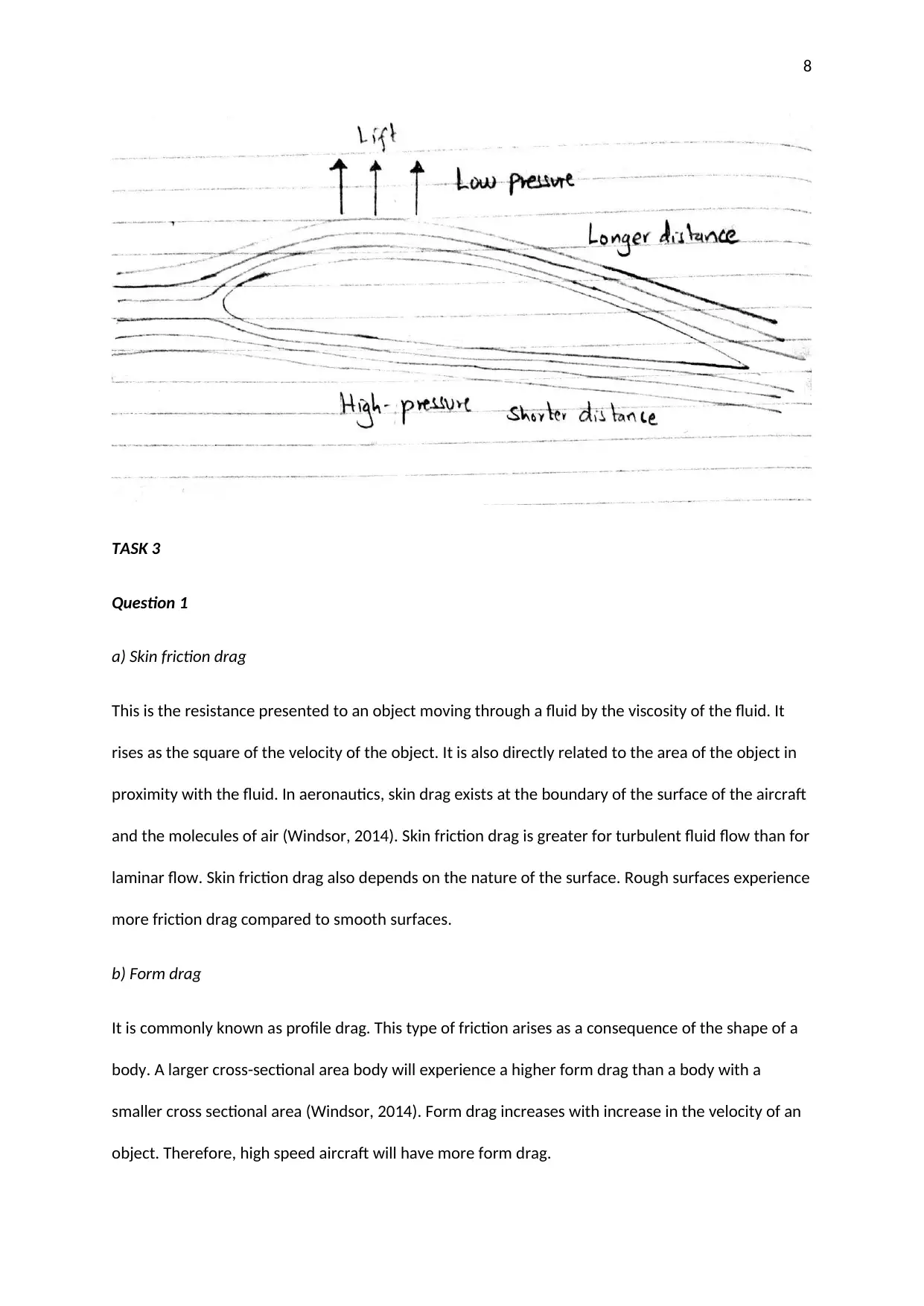
8
TASK 3
Question 1
a) Skin friction drag
This is the resistance presented to an object moving through a fluid by the viscosity of the fluid. It
rises as the square of the velocity of the object. It is also directly related to the area of the object in
proximity with the fluid. In aeronautics, skin drag exists at the boundary of the surface of the aircraft
and the molecules of air (Windsor, 2014). Skin friction drag is greater for turbulent fluid flow than for
laminar flow. Skin friction drag also depends on the nature of the surface. Rough surfaces experience
more friction drag compared to smooth surfaces.
b) Form drag
It is commonly known as profile drag. This type of friction arises as a consequence of the shape of a
body. A larger cross-sectional area body will experience a higher form drag than a body with a
smaller cross sectional area (Windsor, 2014). Form drag increases with increase in the velocity of an
object. Therefore, high speed aircraft will have more form drag.
TASK 3
Question 1
a) Skin friction drag
This is the resistance presented to an object moving through a fluid by the viscosity of the fluid. It
rises as the square of the velocity of the object. It is also directly related to the area of the object in
proximity with the fluid. In aeronautics, skin drag exists at the boundary of the surface of the aircraft
and the molecules of air (Windsor, 2014). Skin friction drag is greater for turbulent fluid flow than for
laminar flow. Skin friction drag also depends on the nature of the surface. Rough surfaces experience
more friction drag compared to smooth surfaces.
b) Form drag
It is commonly known as profile drag. This type of friction arises as a consequence of the shape of a
body. A larger cross-sectional area body will experience a higher form drag than a body with a
smaller cross sectional area (Windsor, 2014). Form drag increases with increase in the velocity of an
object. Therefore, high speed aircraft will have more form drag.
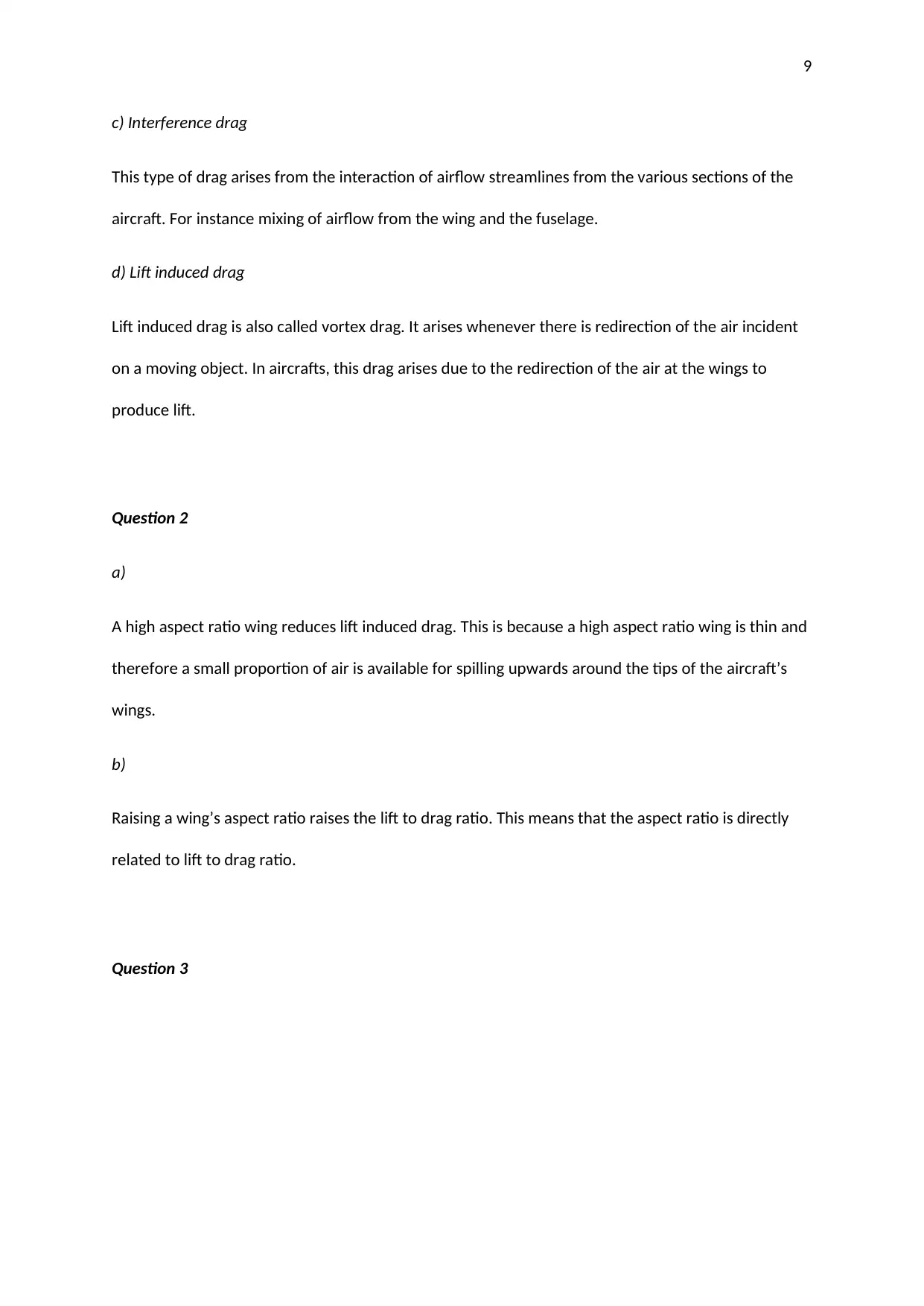
9
c) Interference drag
This type of drag arises from the interaction of airflow streamlines from the various sections of the
aircraft. For instance mixing of airflow from the wing and the fuselage.
d) Lift induced drag
Lift induced drag is also called vortex drag. It arises whenever there is redirection of the air incident
on a moving object. In aircrafts, this drag arises due to the redirection of the air at the wings to
produce lift.
Question 2
a)
A high aspect ratio wing reduces lift induced drag. This is because a high aspect ratio wing is thin and
therefore a small proportion of air is available for spilling upwards around the tips of the aircraft’s
wings.
b)
Raising a wing’s aspect ratio raises the lift to drag ratio. This means that the aspect ratio is directly
related to lift to drag ratio.
Question 3
c) Interference drag
This type of drag arises from the interaction of airflow streamlines from the various sections of the
aircraft. For instance mixing of airflow from the wing and the fuselage.
d) Lift induced drag
Lift induced drag is also called vortex drag. It arises whenever there is redirection of the air incident
on a moving object. In aircrafts, this drag arises due to the redirection of the air at the wings to
produce lift.
Question 2
a)
A high aspect ratio wing reduces lift induced drag. This is because a high aspect ratio wing is thin and
therefore a small proportion of air is available for spilling upwards around the tips of the aircraft’s
wings.
b)
Raising a wing’s aspect ratio raises the lift to drag ratio. This means that the aspect ratio is directly
related to lift to drag ratio.
Question 3
⊘ This is a preview!⊘
Do you want full access?
Subscribe today to unlock all pages.

Trusted by 1+ million students worldwide
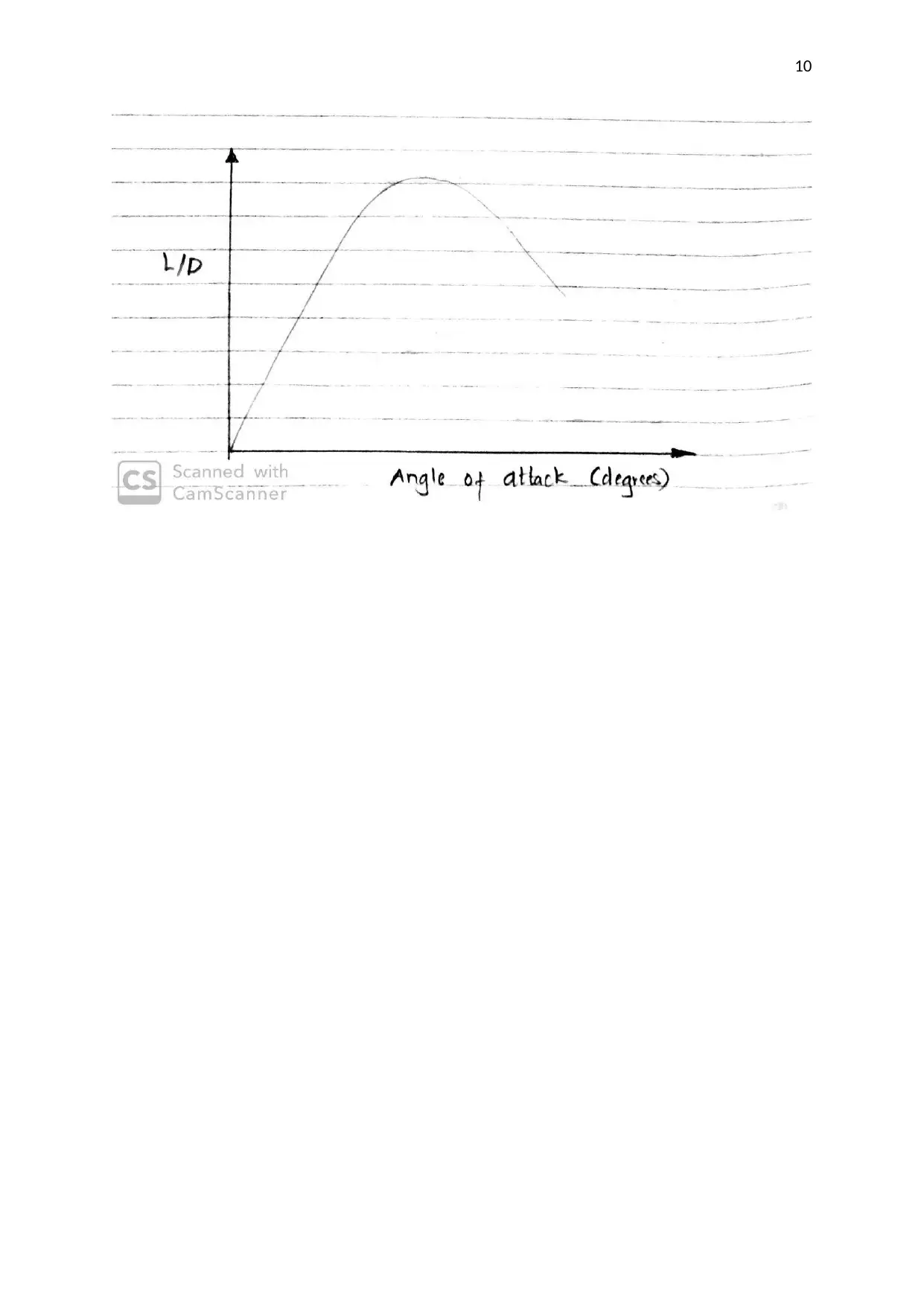
10
Paraphrase This Document
Need a fresh take? Get an instant paraphrase of this document with our AI Paraphraser
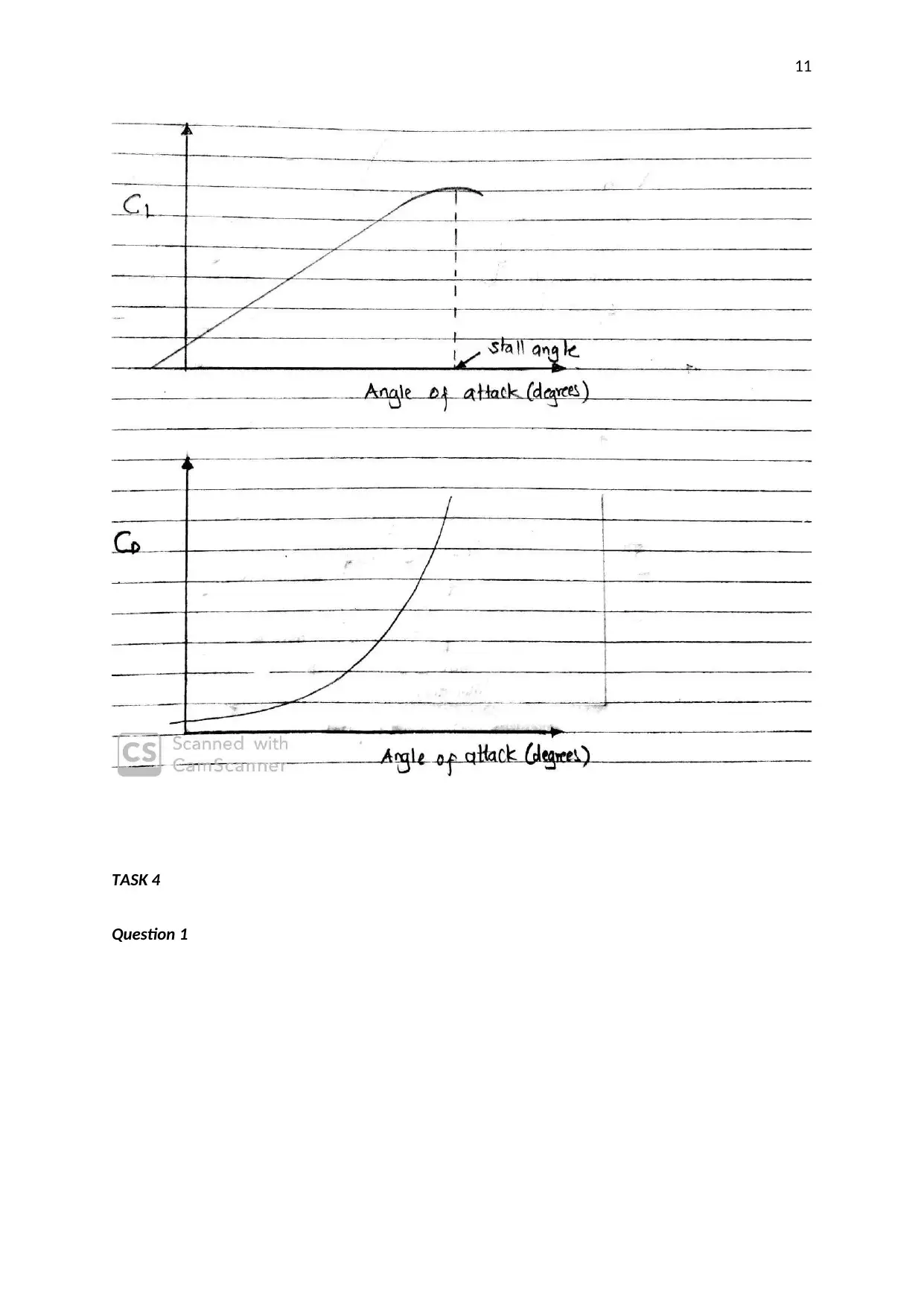
11
TASK 4
Question 1
TASK 4
Question 1
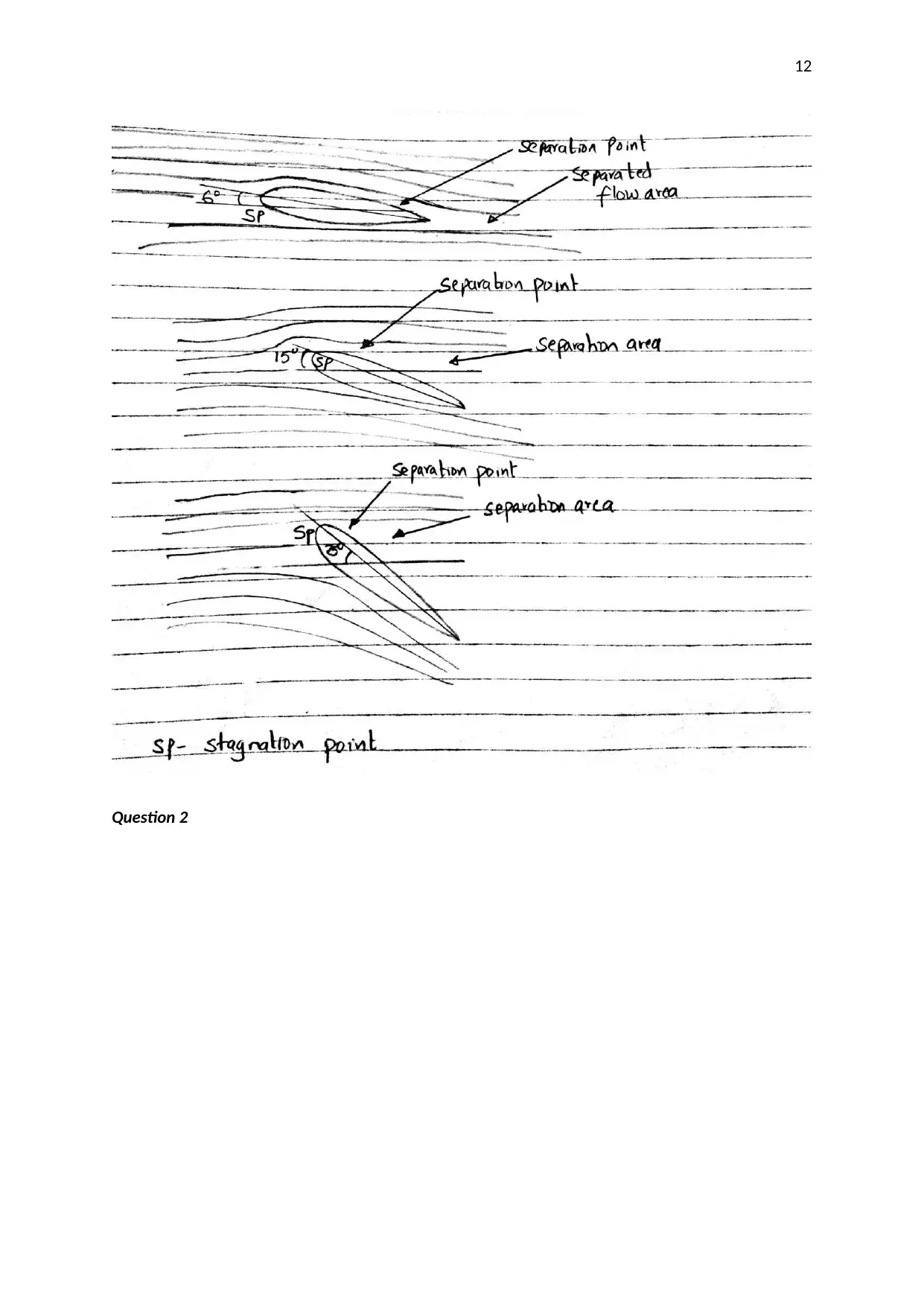
12
Question 2
Question 2
⊘ This is a preview!⊘
Do you want full access?
Subscribe today to unlock all pages.

Trusted by 1+ million students worldwide
1 out of 16
Your All-in-One AI-Powered Toolkit for Academic Success.
+13062052269
info@desklib.com
Available 24*7 on WhatsApp / Email
![[object Object]](/_next/static/media/star-bottom.7253800d.svg)
Unlock your academic potential
Copyright © 2020–2025 A2Z Services. All Rights Reserved. Developed and managed by ZUCOL.

